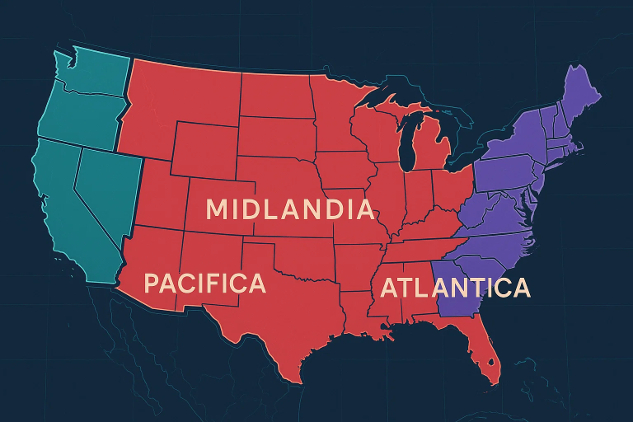
In This Article
- Could the U.S. really break apart into multiple nations?
- What role does Trump play in fueling secession talk?
- How do Canadian provinces like Alberta and Quebec fit into the story?
- What lessons can we learn from Yugoslavia’s breakup?
- Could division actually pave the way for renewal and cooperation?
Could a US Breakup Empower Everyone?
by Robert Jennings, InnerSelf.comHistory has shown that no conflict truly buries an idea. After Appomattox, whispers of state independence and talk of regional autonomy never entirely disappeared. In fact, they’ve re-emerged in various costumes, sometimes as libertarian fantasies, sometimes as localist resistance to Washington’s overreach, and lately, as open threats wrapped in populist bravado. But amidst these echoes, there's a glimmer of hope-the potential for a peaceful breakup, a renewal rather than a disaster.
California has its “Calexit” dreamers, Texas politicians occasionally puff out their chests and mutter about going it alone, and the Pacific Northwest has flirted with the Cascadia movement for decades. Even Vermont once tried to remind everyone it was a republic before it became a state. In short, the “secession movement” is not new. It is a recurring fever, spiking whenever people feel Washington no longer speaks for them. Right now, the fever is running hot.
Enter Donald Trump, the Chaos Conductor
Trump has always thrived on division. His politics are less about building anything and more about breaking things, norms, alliances, and truth itself. He talks of a “national divorce” not because he wants genuine independence for regions, but because chaos gives him power. He floated tariffs designed to punish Canada, then half-joked about annexing Alberta like a mob boss eyeing a neighbor’s backyard grill. The MAGA movement feeds off grievance, and what’s a juicier grievance than whispering that maybe the United States should no longer be united?
But here’s the paradox: by stoking these flames, Trump may be accelerating conversations far bigger than his ego. People are asking questions they wouldn’t have dared to raise a decade ago: What if America really did split? Would it be the end of everything, or the beginning of something new?
Canada’s Parallel Fractures
Look north, and you’ll see familiar cracks. Quebec has carried the torch of separatism for generations, sometimes nearly breaking free. Alberta, frustrated with Ottawa, toys with the idea of an “Alberta exit.” And Cascadia, the dream of uniting British Columbia with Washington and Oregon, remains a quiet fantasy among those who see more in common across the border than within their own federal systems. If the United States seriously fractures, don’t assume Canada will stand smugly untouched. History shows that neighbors often catch the fever.
If Alberta were to leave Canada, or if Quebec were to reignite its independence drive, new alignments could emerge. Imagine Alberta linking arms with Montana and the Dakotas, or Cascadia blossoming into an ecological republic spanning the Pacific Northwest. These scenarios sound radical until you remember that borders, as we know them, are just pencil marks on maps drawn by men long dead.
The Yugoslav Reminder
Of course, not all breakups are created equal. Yugoslavia’s collapse in the 1990s stands as a brutal reminder of what happens when nationalist ambition and ethnic hatred fuel separation. What started as political discontent dissolved into war, ethnic cleansing, and a fractured region still healing decades later. The lesson? Breakup without cooperation is a recipe for disaster.
Yet even Yugoslavia offers another lesson: the artificial unions of states can only last so long if the underlying cultures and aspirations remain ignored. The breakup gave rise to several independent countries that, while scarred, now have their own agency. Painful as it was, the split was inevitable once the glue lost its stickiness.
Global Momentum Toward Smaller Units
The US isn’t alone in facing murmurs of secession. Scotland continues to press for independence from the United Kingdom. Catalonia rattles Spain’s foundations with its demands for independence. Across the globe, people are questioning whether giant, centralized nation-states are suited for modern realities. Smaller units, they argue, are more agile, more representative, and less trapped in the paralysis of gridlock.
Seen in this light, the US breakup would not be an outlier but part of a broader global shift. Maybe the real anomaly is that America has held together for nearly 250 years despite its vast contradictions. A family this dysfunctional rarely stays under one roof forever. The potential for the US to join this global trend could be a comforting thought for those considering the possibility of a breakup.
Could This Actually Benefit Everyone?
Here’s the unthinkable proposition: maybe breaking up would actually make things better. Imagine three or more nations emerging from the United States. One built on conservative values, one embracing progressive policies, another forging a centrist or regional identity. Each could govern itself without being constantly sabotaged by the other side. Instead of endless deadlock, we’d see laboratories of democracy, different systems competing, cooperating, even learning from each other. This could lead to more effective governance, greater representation, and a reduction in political gridlock.
Would it be messy? Of course. But America is already dirty. At least this way, the mess would have boundaries, and the citizens could choose which vision they wanted to live under. The Canadian provinces that often feel suffocated by Ottawa might find natural alliances with these new entities, creating cross-border nations bound by shared interests instead of imposed unions.
Renewal Through Division
Division does not have to mean destruction. Like pruning a tree, sometimes cutting back allows stronger growth. The real question isn’t whether America could survive a breakup; it’s whether it can survive without one. The paralysis of polarization is already weakening democracy, eroding trust, and leaving citizens feeling alienated. Perhaps the act of re-drawing borders could give rise to renewed cooperation, not in the form of a forced unity, but in voluntary partnerships. These partnerships could lead to a more harmonious and productive relationship between the new nations.
Think of the European Union. Countries that once slaughtered each other on battlefields now cooperate economically and politically while retaining independence. A post-breakup America might look similar: multiple sovereign nations choosing collaboration where it benefits all. The breakup, in that sense, isn’t the death of America but the rebirth of its promise, freedom to choose, freedom to govern, freedom to renew.
Soft Secession Through Public Health, Governance, and Revenue
What makes the Canadian system so interesting is not just the strength of its provinces but the way they can collaborate. Quebec shapes its own civil law. Alberta exerts outsized control over energy. Provinces often move as blocs when negotiating with Ottawa, and in doing so, they create a layer of authority that sits between local government and national unity.
Now, picture the United States evolving in a similar direction. States may begin banding together into regional blocs that operate like provinces. This is not speculation so much as a description of what is already happening.
The West Coast Health Alliance has taken control of vaccine policy after the collapse of trust in federal guidance. The Northeast has long coordinated on climate policy through shared emissions programs. Western states already manage water through compacts that sometimes overlook Washington. In each case, regional cooperation fills the space where the federal system is either absent or distrusted.
Extend this further, and the outlines of a new order emerge. Imagine regions collecting taxes on behalf of Washington, keeping a portion for their own priorities, and sending the rest to the Treasury. It is legally impossible today, but if Congress fell under the sway of successionist-minded lawmakers, such a delegation could be enacted with a simple vote.
The Constitution gives Congress the power to levy and collect taxes; it does not forbid Congress from outsourcing that task to the states themselves. At that moment, sovereignty would shift. The federal government would cease to be the exclusive collector of revenue, and power would settle in the hands of regions that could operate as gatekeepers.
This is what soft succession looks like in its most potent form. Not secession in the dramatic nineteenth-century sense of states storming out of the Union, but secession by layering. New provincial-style authorities grow up within the Union, pooling states into blocs that can run health care, control resources, and even manage revenue.
Washington remains intact on paper, but in practice, it is negotiating with regions rather than commanding states. That is how a federal republic gradually, and almost imperceptibly, slides into a looser confederation.
Fear the Stagnation, Not the Breakup
Every empire falls. Every Union eventually faces the question of whether it still works. The US is no exception. The choice isn’t between breakup and eternal unity, it’s between evolution and stagnation. Trump, in his blundering way, may have cracked open a door no one can close again. And maybe that’s not the tragedy we think it is. Perhaps it’s the invitation to build something new, something better, something that finally lives up to the rhetoric America has been selling the world for two centuries.
So, if you hear the whispers of a breakup, don’t panic. History shows that out of fracture often comes renewal. The challenge is to make sure that, unlike Yugoslavia’s breakup, if it comes, is guided not by hate, but by a desire to finally live honestly with our differences.
Music Interlude
About the Author
 Robert Jennings is the co-publisher of InnerSelf.com, a platform dedicated to empowering individuals and fostering a more connected, equitable world. A veteran of the U.S. Marine Corps and the U.S. Army, Robert draws on his diverse life experiences, from working in real estate and construction to building InnerSelf with his wife, Marie T. Russell, to bring a practical, grounded perspective to life’s challenges. Founded in 1996, InnerSelf.com shares insights to help people make informed, meaningful choices for themselves and the planet. More than 30 years later, InnerSelf continues to inspire clarity and empowerment.
Robert Jennings is the co-publisher of InnerSelf.com, a platform dedicated to empowering individuals and fostering a more connected, equitable world. A veteran of the U.S. Marine Corps and the U.S. Army, Robert draws on his diverse life experiences, from working in real estate and construction to building InnerSelf with his wife, Marie T. Russell, to bring a practical, grounded perspective to life’s challenges. Founded in 1996, InnerSelf.com shares insights to help people make informed, meaningful choices for themselves and the planet. More than 30 years later, InnerSelf continues to inspire clarity and empowerment.
Creative Commons 4.0
This article is licensed under a Creative Commons Attribution-Share Alike 4.0 License. Attribute the author Robert Jennings, InnerSelf.com. Link back to the article This article originally appeared on InnerSelf.com
Further Reading
American Nations: A History of the Eleven Rival Regional Cultures of North America
Colin Woodard’s insightful book maps the United States as a patchwork of regional cultures, each with its own values and history. It helps explain why political divisions run so deep and why secessionist movements keep reappearing. A must-read for anyone considering whether the U.S. can remain united or is destined to fragment.
Amazon: American Nations
Divided We Fall: America’s Secession Threat and How to Restore Our Nation
David French explores the dangers of political polarization and entertains the possibility of secession. He argues that while a breakup could happen, Americans still have the power to find common ground and build a more tolerant future. This book directly addresses the same questions raised in your article.
Amazon: Divided We Fall
Break It Up: Secession, Division, and the Secret History of America’s Imperfect Union
Richard Kreitner reveals that secession isn’t a fringe idea but a constant undercurrent in U.S. history. From the founding to the present day, the notion of breaking apart has never been far from political discourse. His research provides rich context for today’s “Calexit” and “Texit” debates.
Amazon: Break It Up
Why Nations Fail: The Origins of Power, Prosperity, and Poverty
Daron Acemoglu and James Robinson analyze why some states thrive while others collapse. Their framework for understanding institutions sheds light on whether smaller nations born out of a U.S. breakup could succeed, or repeat the same mistakes. A global perspective that grounds the secession debate in broader history.
Amazon: Why Nations Fail
The Once and Future Liberal: After Identity Politics
Mark Lilla critiques the fragmentation of U.S. politics and suggests ways to rebuild a shared national vision. His perspective contrasts sharply with secessionist arguments, offering readers a lens to consider whether renewal requires unity rather than division.
Amazon: The Once and Future Liberal
Article Recap
By connecting the history of secession movements with modern talk of a US breakup, this article shows how fragmentation might paradoxically fuel renewal. The secession movement reveals both risks and opportunities: from the U.S. and Canada to Yugoslavia’s cautionary tale, division could give rise to stronger, more adaptive nations rooted in cooperation.
#USBreakup #SecessionMovement #Renewal



